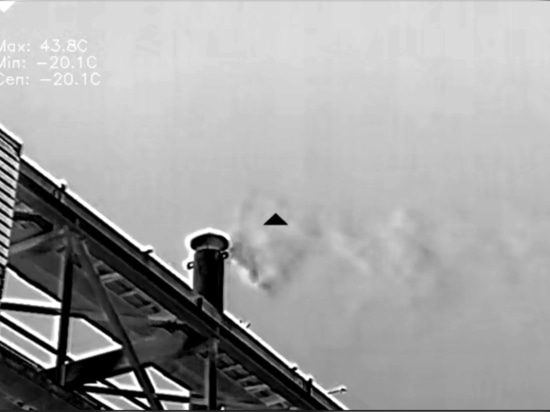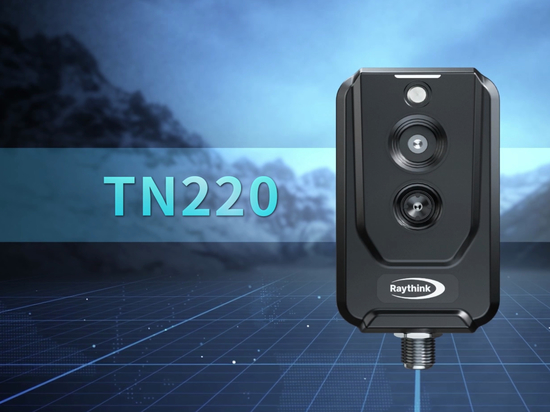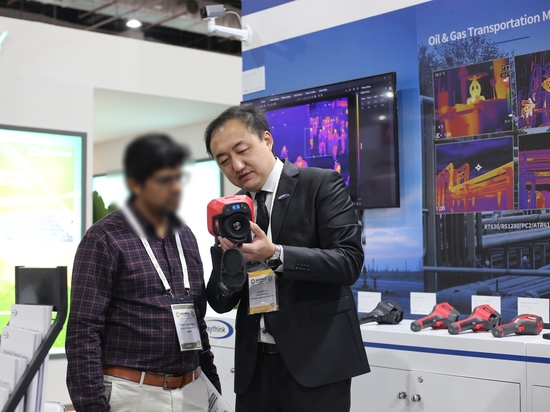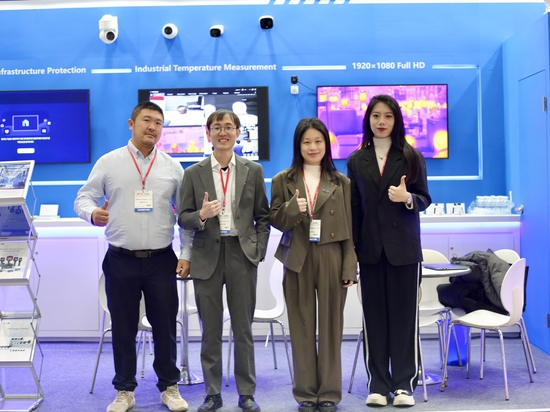
#Industry News
Advantages and Underlying Principles of Optical Gas Imaging Camera
Advantages and Underlying Principles of Optical Gas Imaging Camera
With the continuous development of industrialization, flammable, explosive, and toxic gases have become ubiquitous in various aspects of our lives, either as products, raw materials, or by-products of industrial production. Once leaked, these gases not only pollute the environment but also pose a significant threat to human life and property, potentially causing poisoning, fires, and even explosions.
To mitigate these risks, it is imperative to develop a rapid, accurate, and safe detection method for remotely determining the location and scale of gas leaks.
Limitations of Traditional Gas Detection Methods
Traditional gas leak detection methods, such as bubble testing, funnel testing, or gas detectors, often suffer from the following shortcomings:
Intrusive detection requires production lines to be shut down, leading to downtime and potential damage to equipment.
Limited detection range necessitates proximity to potentially hazardous areas, posing safety risks to operators.
Due to the limited range of gases each device can detect, multiple detectors are necessary to ensure a wider detection spectrum.
Equipment is often bulky and unable to provide on-site results, hindering environmental inspections and timely leak repairs.
Measurement results are often abstract and data-intensive, making analysis difficult.
Small coverage areas require point-by-point or line-by-line inspections, consuming significant time and resources, and increasing the risk of undetected leaks in blind spots.
Advantages of the Optical Gas Imaging Camera
Optical gas imaging cameras have become the preferred tool for gas leak detection due to their safety and efficiency. These devices can quickly detect gas leaks, pinpoint the source, and assess the distribution and dispersion of the gas, effectively preventing accidents and safeguarding life and property.
1. Visualization of Gas Distribution
These cameras can visualize invisible toxic and hazardous gases through optical gas imaging and advanced image enhancement algorithms. Without the need for auxiliary light sources or reflective backgrounds, these devices can directly capture images, enabling rapid localization of leak sources.
2. Safety and Efficiency
Optical gas imaging cameras enable non-contact, long-range, and large-scale detection of target areas. Infrared gas imaging cameras enable inspectors to pinpoint gas leaks precisely without entering hazardous zones, ensuring safe and efficient leak detection.
3. Continuous Operation of the Equipment Is Possible
Unlike traditional methods that require intrusive inspections and often cause equipment downtime, optical gas imaging cameras offer a non-contact solution, allowing for inspections without interrupting operations. This allows for continuous monitoring and detection of gas leaks, reducing production losses.
How Does Optical Gas Imaging Work?
The Basics: Gas Infrared Absorption Spectroscopy
Before delving into how optical gas imaging cameras detect gases, it is essential to understand the concept of “gas infrared absorption spectroscopy” first.
Many gases can absorb infrared energy, but different gases have different absorption characteristics, primarily manifested in different absorption wavelengths. For example, most hydrocarbons, such as benzene and butane, absorb radiation around 3.3 μm, while compounds like SF6 absorb radiation around 10.6 μm.
The Specific Principle of Absorption Characteristics and Wavelength Range
Absorption at Specific Wavelengths: Different gas molecules possess unique vibrational and rotational modes, corresponding to specific energy levels. When infrared radiation interacts with gas molecules, absorption only occurs when the energy of a photon precisely matches the energy difference between two energy levels of the molecule. Therefore, gas absorption of infrared radiation is selective and occurs only within specific wavelength ranges.
Quantized Energy Levels: Vibrational energy levels of molecules are quantized, meaning they can only exist at discrete energy levels. A molecule can only absorb an infrared photon and transition to a higher vibrational state when the photon’s energy precisely matches the energy difference between two quantized energy levels.
Precondition for Gas to Absorb Infrared Radiation
Energy Match: As stated in the text, the energy of an infrared photon must precisely match the energy difference between two energy levels of a molecule for absorption to occur. This ensures that the molecule can only absorb specific energies, meaning the gas will only absorb infrared radiation at specific wavelengths.
Dipole Moment Change: The absorption process also requires that the vibrational transition of a molecule must be accompanied by a change in its instantaneous dipole moment. This change in dipole moment gives rise to absorption peaks, which is both a necessary and sufficient condition for the generation of infrared absorption spectra.
Examples of Gases Detectable at Different Wavelengths
Wavelengths Detectable Gas Types
7-14μm CH₄, C₃H₈, SO₂, N₂O
8.0-8.6μm Refrigerant Gas
10.3-10.8μm SF₆, NH₃, C₂H₄
3.2-3.4μm VOCs
4.2-4.4μm CO₂
4.5-4.7μm CO
How Do Optical Gas Imaging Cameras Detect Gases Based on Infrared Absorption Spectroscopy?
Optical gas imaging (OGI) employs infrared cameras equipped with spectral filters to visualize otherwise invisible gas leaks. The working principle involves measuring infrared radiation transmitted through a volume of gas. By using band-pass filters placed in front of the detector, OGI cameras limit the range of wavelengths that can pass through, allowing for the detection of specific gases based on their unique infrared absorption spectra.
If there’s gas between the OGI camera and the target area, the infrared radiation passing through the gas will be absorbed at wavelengths corresponding to the filter’s passband. By using a narrowband filter centered on a wavelength where the gas exhibits strong absorption, the camera can enhance the visibility of the gas. The gas effectively “blocks” more radiation from objects behind it, creating a contrast in infrared intensity between the gas and the background.
The OGI camera is capable of detecting this differential infrared radiation and converting it into a visual thermal image.
Which Gases Can Optical Gas Imaging Cameras "See"? Can They Detect All Gases?
Optical gas imaging cameras operate on the principle of selective absorption of infrared radiation by specific gases. The camera is equipped with a bandpass filter that allows only a narrow range of infrared wavelengths to pass through. Consequently, the camera can only detect gases that absorb infrared radiation within this specific wavelength range.
The ability of an OGI camera to detect a gas is directly related to the gas’s infrared absorption characteristics within the specific wavelength range of the filter. Gases that do not absorb infrared radiation within this range, such as helium, oxygen, and nitrogen, cannot be visualized. Moreover, different gases have different absorption spectra, which means gases with wavelengths beyond the OGI camera’s response range cannot be detected
Can Optical Gas Imaging Be Used to Identify Gases?
While optical gas imaging (OGI) is well-suited for detecting gas leaks, it is not ideal for gas identification. Identifying a specific gas requires knowledge of the gas’s unique absorption spectrum and the use of a corresponding spectral filter. OGI cameras can detect the presence of a gas, but they cannot differentiate between different types of gases within the same gas family. For example, a thermal camera designed to detect hydrocarbons cannot distinguish between different types of hydrocarbons.
Conclusion
Optical gas imaging provides a powerful and effective method for gas detection. By utilizing the unique infrared absorption spectra of different gases, OGI cameras can visualize gas leaks that are invisible to the naked eye. This technology offers real-time, non-contact detection, making it a valuable tool for various industries to detect gas leaks and prevent incidents such as hazardous gas emissions, ensuring safe production.
If you happen to need a tool to quickly and accurately detect gas leaks, the Raythink OGI handheld camera can be your perfect choice! Our RG Series OGI handheld camera can detect dozens of gases such as natural gas (CH4), Freon, ammonia (NH3), and sulfur hexafluoride (SF6). This series is ideal for gas security, emission management, and equipment maintenance in industries such as oil and gas, petrochemicals, environmental protection, and emergency response. Click here to learn more about the RG Series OGI handheld camera if you’re interested!





